
Louis Comfort Tiffany was an American artist and designer who worked in the decorative arts and is best known for his work in stained glass. He is the American artist most associated with the Art Nouveau and Aesthetic movements. He was affiliated with a prestigious collaborative of designers known as the Associated Artists, which included Lockwood de Forest, Candace Wheeler, and Samuel Colman. Tiffany designed stained glass windows and lamps, glass mosaics, blown glass, ceramics, jewellery, enamels, and metalwork. He was the first design director at his family company, Tiffany & Co., founded by his father Charles Lewis Tiffany.

John La Farge was an American artist whose career spanned illustration, murals, interior design, painting, and popular books on his Asian travels and other art-related topics. La Farge made stained glass windows, mainly for churches on the American east coast, beginning with a large commission for Henry Hobson Richardson's Trinity Church in Boston in 1878, and continuing for thirty years. La Farge designed stained glass as an artist, as a specialist in color, and as a technical innovator, holding a patent granted in 1880 for superimposing panes of glass. That patent would be key in his dispute with contemporary and rival Louis Comfort Tiffany.

The Charles Hosmer Morse Museum of American Art, a museum noted for its [[[art nouveau]] collection, houses the most comprehensive collection of the works of Louis Comfort Tiffany found anywhere, a major collection of American art pottery, and fine collections of late-19th- and early-20th-century American paintings, graphics and the decorative arts. It is located in Winter Park, Florida.

Samuel Colman was an American painter, interior designer, and writer, probably best remembered for his paintings of the Hudson River.
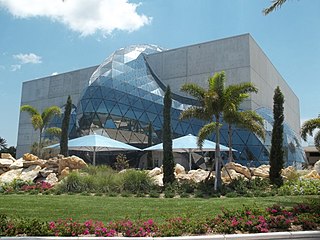
The Salvador Dalí Museum is an art museum in St. Petersburg, Florida, United States, dedicated to the works of Salvador Dalí. Designed by Yann Weymouth, the museum is located on the downtown St. Petersburg waterfront by 5th Avenue Southeast, Bay Shore Drive, and Dan Wheldon Way.
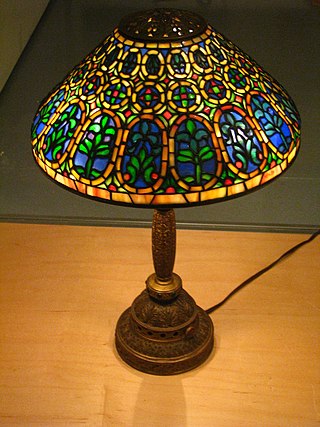
A Tiffany lamp is a type of lamp with a camed glass shade designed by Louis Comfort Tiffany or colleagues, and made in his design studio. The glass in the lampshades is put together with the copper-foil technique instead of leaded, the classic technique for stained-glass windows. Tiffany lamps are considered part of the Art Nouveau movement. Considerable numbers of designs were produced from 1893 onwards.
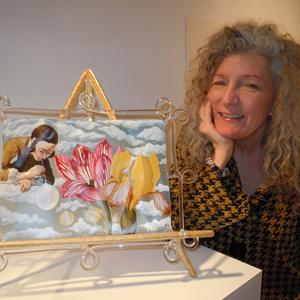
Ginny Ruffner is a pioneering American glass artist based in Seattle, Washington. She is known for her use of the lampworking technique and for her use of borosilicate glass in her painted glass sculptures.

Laurelton Hall was the home of noted artist Louis Comfort Tiffany, located in Laurel Hollow a village in the town of Oyster Bay in Long Island, New York. The 84-room mansion on 600 acres of land, designed in the Art Nouveau style, combined Islamic motifs with connection to nature, was completed in 1905, and housed many of Tiffany's most notable works, as well as serving as a work of art in and of itself. It was also commonly referred to as the "Oyster Bay estate".

Clara Driscoll of Tallmadge, Ohio, was head of the Tiffany Studios Women's Glass Cutting Department, in New York City. Using patterns created from the original designs, these women selected and cut the glass to be used in the famous lamps. Driscoll designed more than thirty Tiffany lamps produced by Tiffany Studios, among them the Wisteria, Dragonfly, Peony, and from all accounts her first — the Daffodil.
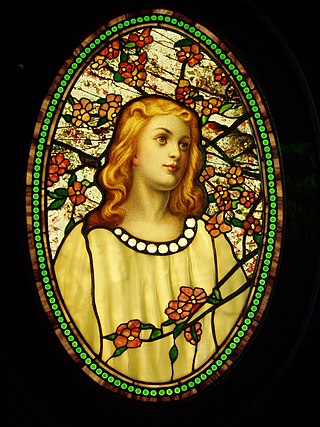
Tiffany glass refers to the many and varied types of glass developed and produced from 1878 to 1933 at the Tiffany Studios in New York City, by Louis Comfort Tiffany and a team of other designers, including Clara Driscoll, Agnes F. Northrop, and Frederick Wilson.
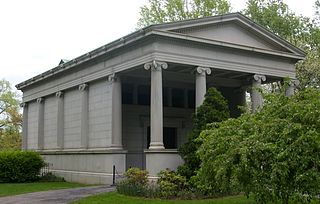
Wade Memorial Chapel is a Neoclassical chapel and receiving vault located at Lake View Cemetery in Cleveland, Ohio, in the United States. It was donated to the cemetery by Jeptha Wade II in memory of his grandfather, cemetery and Western Union co-founder Jeptha Wade. The overall design was by the newly-founded Cleveland area architectural firm of Hubbell & Benes, and was their first commission. The interior's overall design is by Louis Comfort Tiffany based on a preexisting 1893 design. The interior features two mosaics on the right and left hand walls, and a large stained glass window.

Maud Russell Lorraine Freshel was a Boston socialite, designer, and animal rights and vegetarianism activist. She also went by her initials, M. R. L., which she later spelled Emarel.
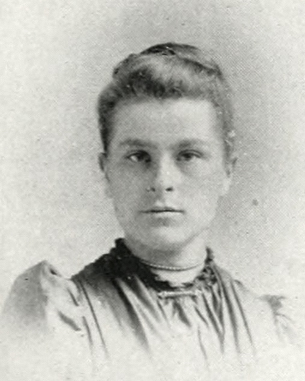
Alice Cordelia Morse was an American designer of book covers in the late 19th and early 20th centuries. Her work was inspired by the Arts and Crafts Movement, and she is often placed as one of the top three book designers of her day.
Martin P. Eidelberg is an American professor emeritus of art history at Rutgers University and an expert on ceramics and Tiffany glass. He is noted for discovering that many floral Tiffany lamp designs were not personally made by Louis Comfort Tiffany, but by an underpaid and unrecognized woman designer named Clara Driscoll.
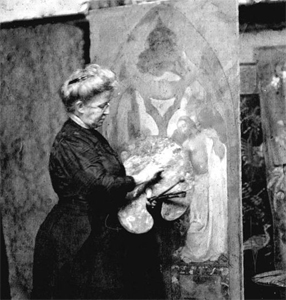
Clara Minter Parrish was an American artist from Alabama. Although she produced a large amount of work in a wide array of media, she is best known for her paintings and stained glass window designs. She was inducted into the Alabama Women's Hall of Fame in 1983.

Patricia Cronin is a New York-based feminist cross-disciplinary artist. Since the early-1990s, Cronin has garnered international attention for her photographs, paintings and sculptures that address contemporary human rights issues. Cronin's conceptual artistic practice transits across many aesthetic platforms addressing social justice issues of gender, sexuality and class, including: lesbian visibility, feminist art history, marriage equality and international rights of women. She subverts traditional art images and forms in a wide range of two and three-dimensional time-honored artists' materials and breathes new life into these images and forms by injecting her specific political content. Her critically acclaimed statue, "Memorial To A Marriage", is the first and only Marriage Equality monument in the world. A 3-ton Carrara marble mortuary sculpture of her life partner and herself was made before gay marriage was legal in the U.S., and has been exhibited widely across the country and abroad. Cronin began her career working for the Anne Frank Stichting (Foundation)Archived 2015-10-25 at the Wayback Machine in Amsterdam installing the traveling exhibition "Anne Frank in the World" in Europe and the U.S. Giving presence to female absence is a consistent thread that runs through and connects each body of work.

Frederick Wilson was a British stained glass artist best known for his work with Tiffany Studios. He was a prominent designer of ecclesiastical windows in the United States during the late 19th and early 20th centuries.

Alfred Heber Hutty was a 20th-century American artist who is considered one of the leading figures of the Charleston Renaissance. His oeuvre ranges from impressionist landscape paintings to detailed drawings and prints of life in the South Carolina Lowcountry. He was active in local arts organizations, helping to found both an art school and an etchers' club.

Art Nouveau glass is fine glass in the Art Nouveau style. Typically the forms are undulating, sinuous and colorful art, usually inspired by natural forms. Pieces are generally larger than drinking glasses, and decorative rather than practical, other than for use as vases and lighting fittings; there is little tableware. Prominently makers, from the 1890s onwards, are in France René Lalique, Emile Gallé and the Daum brothers, the American Louis Comfort Tiffany, Christopher Dresser in Scotland and England, and Friedrich Zitzman, Karl Koepping and Max Ritter von Spaun in Germany. Art Nouveau glass included decorative objects, vases, lamps, and stained glass windows. It was usually made by hand, and was usually colored with metal oxides while in a molten state in a furnace.























